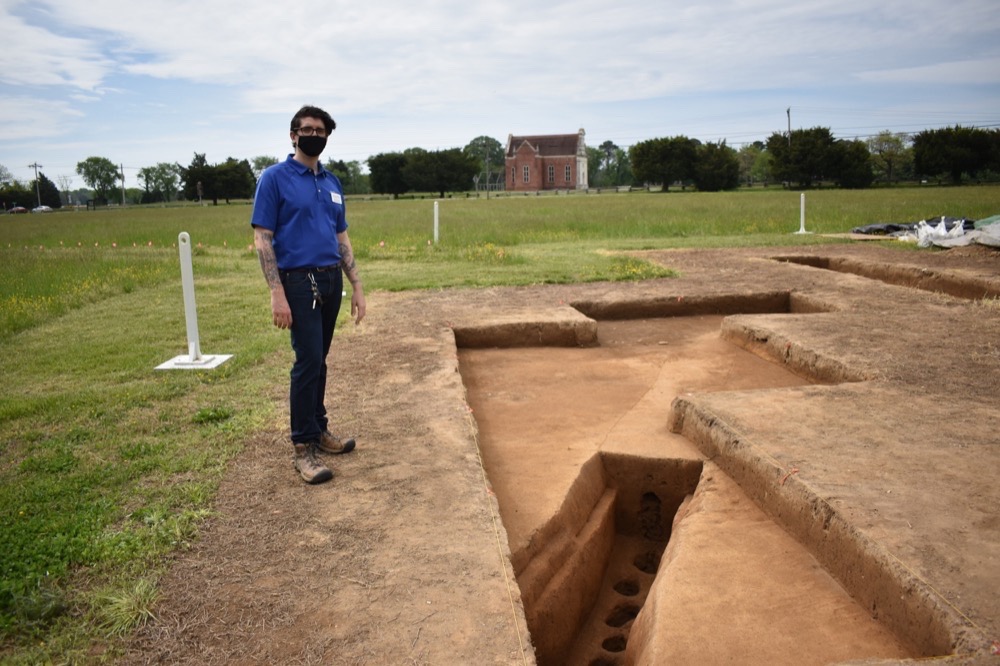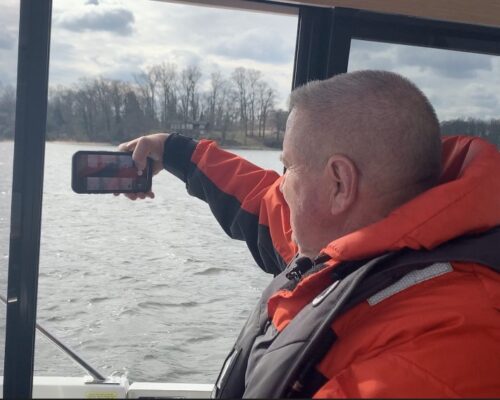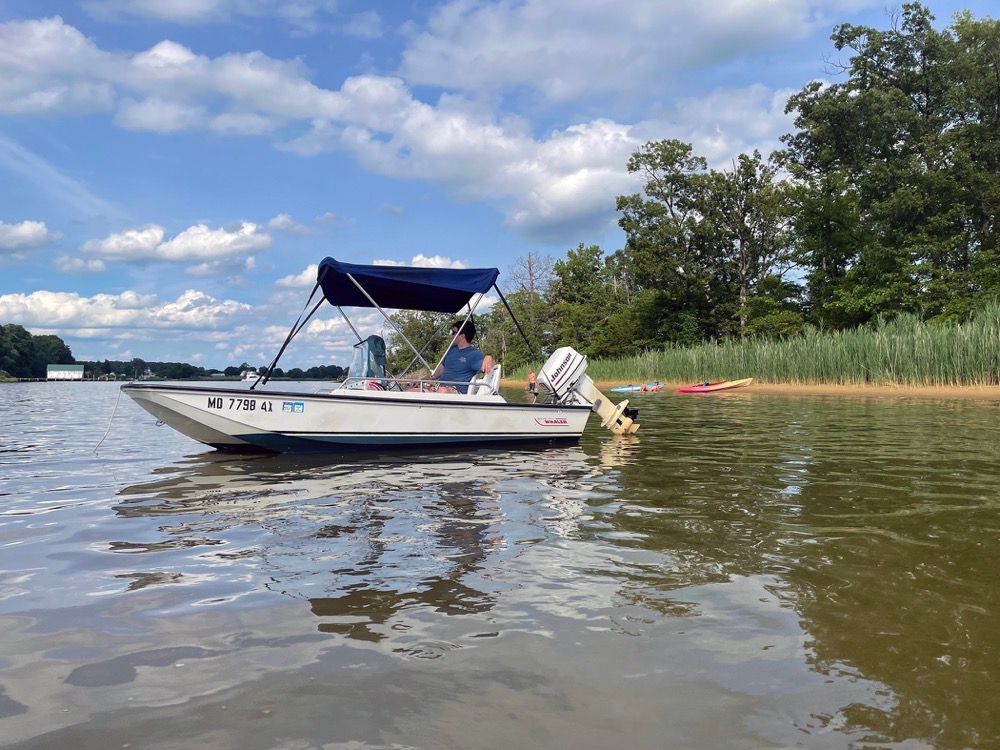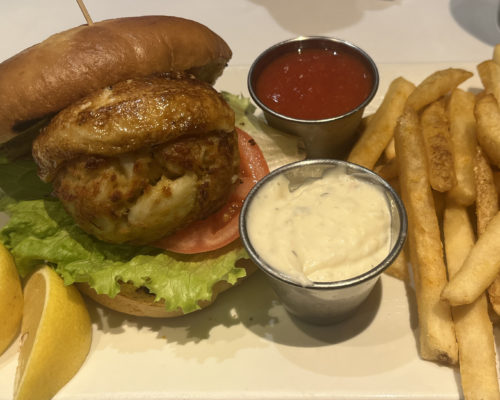Digging into pre-Colonial history in St. Mary’s City
The recently rediscovered St. Mary’s Fort, built in 1634, has garnered lots of excitement as the first European settlement in Maryland. But the area itself had been occupied long before colonist ships made it up the Chesapeake, which is
a key part of the archaeological focus. “Our story begins about 12,000 years ago,” said Travis Parno, director of research and collections at Historic
St. Mary’s City. “I told you it was the long version.”
According to the archaeological record, this was when the first people arrived in Southern Maryland, though it’s still unknown exactly where they were coming from. Artifacts found at the site in Historic St. Mary’s City have been dated back to between 9,500 and 12,000 years ago. Parno says the area of the site would have been an excellent place to settle down, with raised, level ground, fertile soil, and a natural spring within a quarter mile of where St. Mary’s Fort would one day stand.
Corn made its way north from Mesoamerica to the Chesapeake around 650 AD. The adoption of agriculture nudged people into a more sedentary lifestyle. With a predictable source of food close to home, people didn’t have to follow herds for hunting or rely on natural cycles for foraging.
The abundant supply of food caused groups to increase in size and become more complex. By about 1300 AD, people began to settle into fortified villages around the Chesapeake. These fort walls, called palisades, consisted of heavy tree timbers placed side-by-side in trenches to form a wooden barrier.
The Piscataway tribe was emerging around this time, and they would one day become the most influential group in what is now Maryland. But they were not without competitors, and clashed with other tribes in the region. “Usually, you build a wall because you want to keep people out,” Parno said.
In 1634, Maryland’s first English colonists arrived in the Chesapeake aboard the Ark and the Dove. They stopped on St. Clement’s Island for mass and began their search for a new home. Colonial leadership was aware of native people living in the area and went looking for whoever was in charge to discuss settling in areas of present-day Maryland, Parno said. They sailed up the Potomac River and met with the Tayac, or paramount chief, of the Piscataway people.
The colonists were not immediately kicked out of the Chesapeake region, but they were encouraged to find another place to settle somewhere outside of Piscataway territory. The Piscataway had been attacked by neighboring tribes on all sides for about a century at this point, and thought the colonists could bring more trade to the area and provide a buffer zone against invaders, Parno said.
The colonists were told to settle in an area along the Potomac that was inhabited by the Yaocomico, a group allied with the Piscataway. The Yaocomico agreed to vacate a section of their village so the colonists could live there. This process was overall believed to be a peaceful, economic transaction, explained Parno, despite discrepancies in the concept of land ownership between the Native American and European schools of thought. The colonists saw ownership as an absolute thing, that if you owned the land you had complete control over who and what could be there. The Native Americans saw land ownership as more of a permission to use the land’s resources rather than a
binding contract.
After settling into a few of the houses the Yaocomico had left behind, the colonists began constructing St. Mary’s Fort, and even held mass in native structures while their chapel was being built. In a 1634 letter from Leonard Calvert, Maryland’s first governor, to a friend in England, Calvert described the fort as a 120-yard square with palisade walls and four flanks, or positions along the wall to mount cannons. “We’ve been doing archaeology here for 50-odd years,” Parno said “But the piece that was missing was St. Mary’s Fort.”
In 2017, Parno was able to secure the grant money necessary to hire a specialist, Tim Horsley, to scan the area with ground-penetrating radar. Parno happened to be away on vacation while Horsley conducted his survey and planned to catch up on the progress when he returned.
“He’s not going to find it in the first couple days, right?” laughed Parno. But after the first day, Horsley texted Parno, saying, “I think we have it.” Horsley’s survey had found a dotted black line beneath the ground that vaguely traced a geometric shape. With straight lines and sharp angles, Parno knew this shape couldn’t have occurred naturally.
Each of the dots Horsley had found were the remnants of the timbers used to construct the palisade walls of the fort. Within the outline were other geometric shapes, likely leftover from the cellars and buildings inside.
Among these smaller shapes were
the rectangular footprints of English buildings, as well as more rounded shapes that could have been
native architecture.
The dimensions of the fort were about 104 yards by 58 yards, clearly not the shape described in Calvert’s letter. This is likely due to the fact that the fort was still under construction at the time the missive was written,
said Parno.
A unique element of this colony was its ownership. While the Virginia colony was owned by a joint-stock company and New England colonies were generally formed by religious groups, the St. Mary’s colony was owned privately by the Calvert family. Though the Calverts were trying to gain favor with the Crown by establishing their colony, they also sought a place where they could practice Catholicism openly without fear of persecution, Parno said.
Though “freedom of religion” was a pursuit of the Calverts, it didn’t manifest in the way modern people may see it. These freedoms were expressly for “trinitarian” faiths or subsects of Christianity, Parno said. However, the policies were enforced to varying degrees. There had been Jewish members of the colony, and in most respects, they were treated as an equal part of the community.
Little is known about the treatment of Native religious practices by the colonists, but they likely weren’t extended the same acceptance and protections as European faiths. Nonetheless, this idea of founding a colony without a state-mandated religion was entirely unheard of at the time, explained Henry Miller, a professor of anthropology at St. Mary’s College of Maryland. “This was a really bold experiment,” he said. “And it actually worked.”
In 1638, at a Jesuit plantation down the river from the fort, one of the Catholic overseers was goaded into blaspheming by his Protestant servants, said Miller. After an anti-Protestant outburst, the overseer was brought to court and issued a heavy fine for infringing upon the rights of
his servants.
This practice of freedom of religion was successful for about 60 years, Miller said. But then came a revolution against Charles Calvert, Lord Baltimore, in 1689 as part of the aftermath of the Glorious Revolution in England. Calvert lost control of the colony, and royal governors were appointed to establish the Church of England as the official church of Maryland. In 1704, the governor ordered the sheriff to lock up the St. Mary’s chapel so that it would never again be used for worship. During this period, Catholics were forbidden from holding office or serving in the militia, and were taxed double. “The lesson there is, we can’t take our freedoms for granted,” Miller said.
Together with the People to People Project, a collaborative effort between members of the Piscataway Nation and St. Mary’s archaeologists, Parno plans to provide a fully immersive historical experience in St. Mary’s. By incorporating native voices into their work, People to People has brought the history of the Piscataway Nation to the forefront, rather than using it as set dressing for the colonial era.
The areas near the fort contain a couple of native sites established as early as 3,000 years ago and as recently as 500 years ago, Parno said. He aims to use these sites to illustrate the changing lifeways of the different people that inhabited the area before and after European settlement.
“Treat this 14-acre field as sort of our laboratory of human experience and look at what life has been like in southern Maryland over the last 12,000 years,” he said.
Reconstructed sites offer visitors a firsthand look at what native settlements would have been like in the time before St. Mary’s Fort. The building techniques used to erect the woven structures of the sites have been as authentic to their original construction as possible, save the size of the doors and a few modern fasteners on their older reconstructions.
Examples of native trade goods are displayed outside, with expert staff on hand to explain their origins and usage. This way, visitors are provided with the historical context and cultural backdrop to the eventual English settlement of the area.
“I think there’s a tendency sometimes for people to see colonial forts as this bastion of civilization in an otherwise unoccupied wilderness, and that just isn’t the case, particularly in the Chesapeake,” Parno said.




